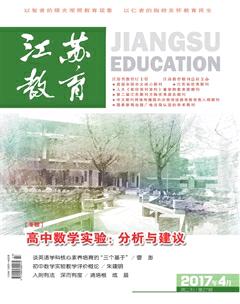还诗歌教学的本义
【摘 要】诗歌是语言艺术的精华,英文诗歌渗透着语言文化内容和人文底蕴。初中学生进行英语诗歌学习,在学习英语基础知识的同时,还要领悟诗意诗境,理解并初步运用诗歌韵脚、诗歌节奏、修辞手法,感受韵律美、节奏美和语言美,从而进一步提升学生的人文素养。
【关键词】赏读;韵脚;节奏;修辞手法;人文素养
【中图分类号】G633.4 【文献标志码】A 【文章编号】1005-6009(2017)27-0024-03
【作者简介】曹澎,江苏省锡山高级中学实验学校(江苏无锡,214177)副校长,高级教师,江苏省特级教师。
一、教材分析
译林版义务教育教科书《英语》八年級上册 Module 2 Nature and the Environment 中Unit 7(简称M2 U7)的中心话题是季节。围绕这一话题,教材在第一板块Comic strip & Welcome中以“Weather and seasons”激活学生对这一话题已有的知识储备,学习有关天气的知识,讨论各自喜欢的季节及原因。在之后的第二板块Reading中,教材呈现一首诗歌Seasons of the Year,此为本节课的教学内容。
本课也是学生在教材中接触到的第二篇诗歌。Seasons of the Year以四季变换入手,抓住四季特点,描述季节之美。全诗分为四个诗节,它语言凝练、韵律和谐、主题鲜明、意境优美。
二、教学目标
本课将诗歌阅读教学定位于“赏读”,引导学生从品味、欣赏的角度进行阅读。通过学习,学生能说出诗歌韵脚、节奏方面的特点,能赏析拟人化的修辞手法,并找出相应诗句,品味诗歌的韵律美,感受节奏美,体悟语言美。
三、教学过程及设计意图
课前循环播放一段四季变换的视频,同时教师介绍自己,与学生相识,一起走进师生共同的学习场。
Step 1 导入
T: Whats the video mainly about?
S: Its about seasons.
T:Yes, its about seasons,changes of seasons. We know a year is divided into four seasons. What are they?
S: Spring, summer, autumn and winter.
T: Right. Now lets have a brainstorm. Please use adjectives and nouns to describe different seasons.
S1: Spring is warm.
S2: Ice cream.
T: Oh, you mean summer reminds you of ice creams.
S3: Autumn is yellow.
S4: Winter is cold/cool/rainy/snowy...学生用了很多词汇来描述四季。
【设计意图】课前播放的视频自然而然地把学生引入“四季”这个话题。导入环节中用头脑风暴的形式,让学生在快速搜索已有知识的过程中,用学过的形容词和名词分别描述四个季节,主动思考四季的不同特点,聚焦本课主题“四季”。
Step 2 诗歌赏读
(1)Feel the tone of the poem by listening.
T:Listen, Millie is reading the poem “Seasons of the year”. Please keep your eyes closed and listen.
T:Maybe poems are always as beautiful as pictures. Now lets enjoy the video of the poem with our eyes wide open.
【设计意图】通过先闭眼聆听,再睁眼观看的形式,让学生听读感知,走进诗境。闭眼聆听时,学生就有了强烈的期待,睁眼观看时,激起了更强的学习欲望。这一设计,抓住了学生的好奇心,以优美的诗句配以欢快清新的音乐和唯美的画面,激发学生进一步深入赏读的渴望。
(2)Understand the meaning of the poem by referencing the PowerPoint presentation.
T: After reading the poem, Millie is drawing pictures of the four seasons. Help her write the correct seasons in the blanks and then match each season with the descriptions in the poem.
T: Please read by yourselves and ask me for help if you have difficulties in understanding the poem.
【设计意图】这一环节,先利用课本中的“诗画匹配”练习,帮助学生结合文本,随文识字,学习新单词,再让学生在自主朗读中针对自己的理解疑难处,采用主动提问的学习策略,用语境和图片帮助理解shower,memory,drop,temperature等单词。诗歌中有很多地道的词汇和表达法,如April showers,sweet memories,lazy afternoons等,通过诗画结合的学习方式让学生实现内化。整个词汇教学的过程没有打乱本节课诗歌赏读的完整性,始终建立在“整体赏读”的设计中。学生跟着视频一起朗诵,让学生进一步体会“诗歌是语言的音乐”。
(3)Feel the rhyme and rhythm of the poem by repeatedly reading and reciting.
T: Is the poem beautiful?
S: Yes.
T: Why do you think so?
学生思考,但较少回答出来。教师引导。
T:Maybe one of the reasons is that poems have their own characteristics. What are they?
学生仍然深思,难以回答。教师继续引導。
T:Now heres a Chinese ancient poem. Maybe we can learn from it.(Show the poem《春晓》)
T:These words “xiao, niao, shao” have similar sounds, and we call them rhyming words. Yes, a poem has its own rhyme. Words that rhyme with each other are often used in poems.
T:And we can stress or emphasize the words which are important. Make the stressed syllables strong, and the unstressed syllables weak and quick. So the poem has its own rhythm. The rise and fall of the voice in reading with rhythm means “cadence”. The rhythm and cadence of the poem delight our ears.
T: And they are the same as English poems.
(呈现翻译家许渊冲的译作:Spring morning/This spring morning in bed Im lying, / Not to wake till birds are crying, / After one night of wind and showers, / How many are the fallen flowers.)
T:Now can you find the words that rhyme in the poem “Seasons of the year”?
S1: Snow rhymes with grow.
S2: Away rhymes with day.
……
T: A poem has its own rhyme and rhythm, and they make poems beautiful. This time lets read the whole poem together with music, feeling the rhyming beauty and the rhythmic beauty.
【设计意图】这一环节旨在带领学生走进诗歌深处,理解诗歌特色。学生因对诗歌知识的匮乏而产生了学习障碍,此时教师由引导转向指导,明确指向学生的学。借助学生极为熟悉的古诗《春晓》,帮助学生了解诗歌的韵脚、节奏。
(4)Appreciate the beauty of the poem by doing detailed reading.
T:Besides the rhyming beauty and the rhythmic beauty, what other beauty can you find in the poem? Can you find the language beauty?
T:Thats because the poet uses some beautiful words and phrases to make the poem beautiful. Now, lets find them.
S:In the sentence “When trees and flowers forget to grow”, the word “forget” is special.
T:Is it like a persons action? Here the writer uses personification to make the poem more beautiful. It gives human form of feelings, ideas to animals, or to inanimate objects.
T: Can you find more examples?
很快学生又找到了play,hide。
T: A famous poet says, “If you really want to know the poem, read it. Read it carefully. Pay attention, read it out loud.” Lets read the poem in roles. I read the first stanza, boys the second, girls the third,and we read the last stanza together.
T: Practise reading the poem in groups of four. Please express your own feelings about each season and then present in class.
【设计意图】从初读、诵读到细读、品读,在步步深入的赏读过程中,学生对本诗的理解也在逐渐加深。这里设计了细读品鉴、美点寻踪,学生赏析了拟人手法,感受诗歌的语言美。设计师生分角色朗读,既让教师做了诗歌朗读的示范,又拉近了师生距离,师生成为学习共同体。
(5)Have a discussion.
1) Why does the poem begin with winter and end with winter?
2) Whats your feeling after reading the poem?
【设计意图】诗歌赏读最终都应落实在学生的理解和感悟上,用各种方式带领学生走进文本,就是为了让学生走出文本时能带上新获取的审美能力、新提升的人文素养和新拓展的审美视界。学生在学会发现美、感受美之后,这首小诗引起了他们心灵的共鸣。
Step 3 读后运用
(1)Put them into the right order.
T: A poem is how the reader reads.
A poem is how the poet writes.
A poem is real. A poem is fake.
A poem is anything. I make it mine.
(2)Complete the poem with “seen, return, room, sky”.(Spring by Robert McCracken具体内容略)
(3)Try to be a poet. Try to write a poem about the season you like best.
【设计意图】给诗句排序、填入诗歌所缺单词,这两项都需要根据韵脚规律,并理解诗歌内容后完成。这实现了知识的迁移,既检测了学生的课堂学习成效,又加深了学生对英文诗歌的了解。这一环节特别设计了诗味十足的语言,一方面使整堂课始终保持浓浓的诗味,另一方面告诉学生诗无达诂,赏读诗歌没有标准答案可循,诗歌理解需要主动的个性化的感悟和思考。另外,让学生在赏读之余、意犹未尽之时,选取自己最喜欢的一个季节,当一回诗人,过一把诗瘾。
Step 4 课后延伸
Revise your own poem after class and the website may help you. http://en8848.com.cn/read/poems.
【设计意图】在课后延伸即作业布置环节,让学生修改课堂习作,继续创作小诗,并提供了英文诗歌网站,帮助学生保持浓厚的学习热情。
四、教后反思
初中学生英语诗歌阅读可以读些什么?可以读语言,读文采,读感情,读思想,读文化承载,等等。我想,诗歌阅读就是要引导学生读出诗歌的美,欣賞诗歌的美,享受诗歌带来的愉悦和美感。
初中学生英语诗歌阅读可以怎么读?诗歌阅读应是基于诗性的阅读,即尊重诗歌的特质。最可能具有“诗性”的阅读方式是体悟,“解释”显然不是诗歌阅读的正确打开方式。在本节课中,本着“多一些朗读,少一些分析;多一些自我体验,少一些微言大义”的原则,笔者从听读感知切入,读悟交错,层层递进,设计了两次听读,两次集体朗读,一次自由朗读,一次分角色朗读,一次小组朗读以及一次朗读展示共八个层次的悟读。我认为,诗性的阅读应该是把所有的生命感官打开,面向诗歌的意象和语言本身,通过诵读得到自己切身的感受。此刻读者不是单纯的欣赏者,而是成为诗歌文本的生产者,读者可以在阅读的过程中产生创造的快乐。
诗歌是语言艺术的精华,英语诗歌渗透着语言文化和人文底蕴。我认为,初中学生的英语诗歌学习,是要在学习英语基础知识的同时,还要领悟诗意诗境,理解并初步运用诗歌韵脚、诗歌节奏、修辞手法,感受韵律美、节奏美和语言美,从而进一步提升学生的人文素养。

